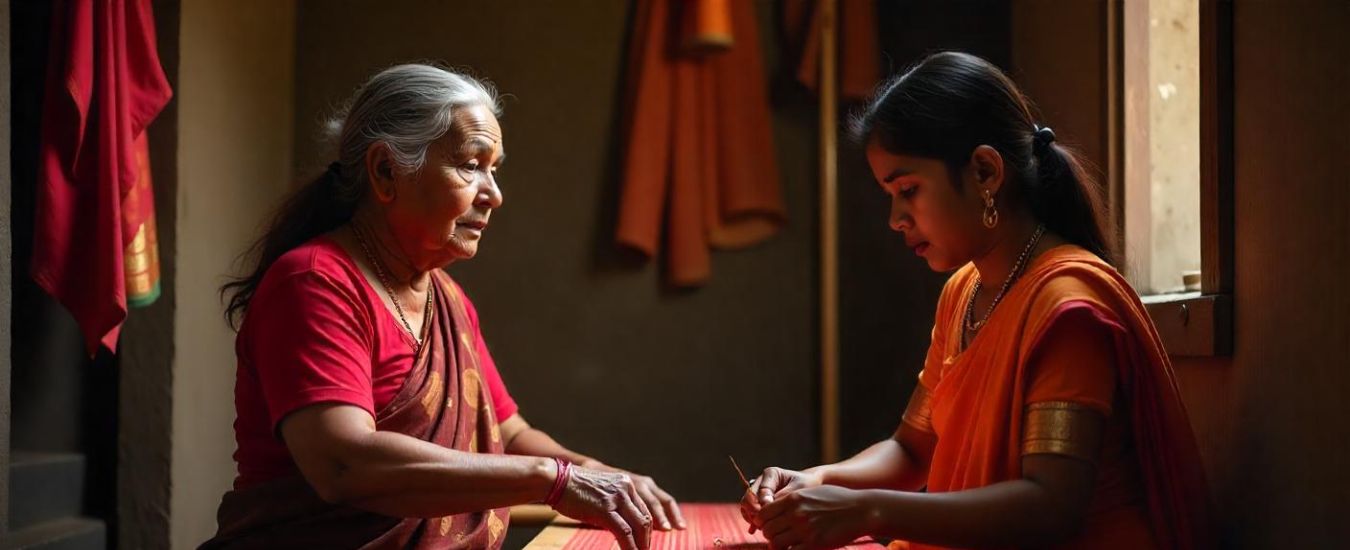Kanjeevaram silk sarees aren’t just outfits—they’re wearable legacies. With roots in ancient India and popularity in modern couture, these masterpieces of textile heritage hold a special place in every Indian wardrobe. From bridal elegance to red-carpet fashion, the obsession with Kanjeevaram is woven into our cultural identity.
Kanjeevaram silk sarees are more than garments—they’re the soul of Indian textile heritage. Whether draped on a bride or displayed in a boutique, they represent a blend of art, culture, and devotion that never goes out of style.
Why We’re Obsessed with Kanjeevaram Silk Sarees?
They shimmer. They drape like a dream. And they tell stories—of tradition, artistry, and devotion. Each saree is a handcrafted heirloom textile, often passed down generations, making it far more than just ethnic wear.
The Origins of Kanjeevaram Silk Sarees
Kanchipuram – The Silk City of India
The famed Kanjeevaram sarees hail from Kanchipuram, Tamil Nadu—rightly known as the “Silk Capital of India.” Legend says the weavers are descendants of Sage Markanda, the celestial weaver. This city has been the nucleus of Indian handloom for centuries.
Weaving as a Generational Legacy
In Kanchipuram, weaving is more than a job—it’s a spiritual and familial duty. Skills are passed down through generations, making this an enduring pillar of Indian craftsmanship.
Sacred Silk: Religion, Temples, and Tradition
Divine Motifs and Temple Architecture
Temple pillars, murals, and sculptures have inspired motifs like peacocks, lotus flowers, and chariots found on sarees. This intersection of architecture and artistry embodies cultural storytelling.
Sarees Offered to Gods
Believe it or not, even deities are adorned in Kanjeevaram silk. Devotees donate sarees to temples, believing that the divine appreciates luxury just as much as we do.
What’s in a Kanjeevaram Silk Sarees? Let’s Unravel It
Pure South Indian Mulberry Silk
Authentic Kanjeevaram sarees use high-quality mulberry silk reared through traditional sericulture methods. The silk is thick, lustrous, and durable.
Zari Work: Real Silver and Gold Threads
The original zari is made from silver threads dipped in gold—contributing to the saree’s luxury fashion appeal. It’s not just sparkle; it’s a sign of prosperity.
The Korvai Technique
Kanjeevaram sarees feature contrasting borders interlocked using the korvai weaving technique—a hallmark of intricate handloom craftsmanship.
The Weaving Process: A Textile Marvel
One Saree, Multiple Hands
Typically, two or three weavers work on different parts of a saree—body, pallu, and border—on separate looms. The coordination involved is nothing short of awe-inspiring.
Interlocked Borders That Last Generations
Thanks to korvai and jacquard weaving methods, the saree’s borders never fray. It’s a technical and artistic feat that machines still can’t duplicate.
Colors, Motifs, and Symbolism
Cultural Codes in Colour
Every shade has meaning: red stands for prosperity, green symbolizes growth, and yellow signals auspiciousness.
Symbolic Motifs
Peacocks mean beauty, mango buttas reflect fertility and temple gopurams indicate devotion. These motifs are more than decorative—they’re cultural emblems.
The Bridal Connection
A Must for South Indian Brides
Kanjeevaram sarees are often considered sacred for weddings. Wearing one is seen as invoking blessings for a happy and prosperous marriage.
Blending Tradition and Modernity
Even minimalistic modern brides include a Kanjeevaram in their trousseau—honouring heritage while keeping up with contemporary tastes.
Real vs. Fake Kanjeevaram: Spotting the Difference
The Silk Mark and Handloom Mark
Authentic sarees carry certifications like the Silk Mark and Handloom Mark—verifying purity and handweaving authenticity.
The Touch and Burn Tests
Real silk feels warm and sounds crisp when rubbed. It turns to ash when burned, unlike synthetic fibers which melt.
Pricing as an Indicator
A genuine Kanjeevaram ranges from 8,000 to over 1 lakh, depending on zari content and thread count. Too cheap? It’s likely not the real deal.
Fun Facts About Kanjeevaram
- Guinness Record: A Kanjeevaram saree with woven Raja Ravi Varma paintings once cost over 40 lakhs.
- 15–30 Days to Weave: Skilled artisans take weeks, sometimes months, to complete a single saree.
- Inspiration from Epics and Nature: Motifs often draw from the Mahabharata, Ramayana, and local flora and fauna.
Kanjeevaram Goes Global
From Chennai to Cannes
Celebrities like Deepika Padukone, Rekha, and Kangana Ranaut have flaunted Kanjeevarams at international events, making them global fashion statements.
International Love
From high-end boutiques in New York to wedding collections in Dubai, the Kanjeevaram is earning worldwide admiration.
Sustainability and Ethics in Silk
Is Kanjeevaram Eco-Friendly?
Natural silk is biodegradable, but ethical sericulture is a concern. Ahimsa silk, a cruelty-free alternative, is emerging, though it lacks the original’s lustre.
Supporting the Weavers
Despite their mastery, many artisans face low wages and a lack of recognition. Buying from weaver cooperatives supports the real heroes behind these masterpieces.
The Revival of Kanjeevaram
Designers Giving It a Twist
Designers like Sabyasachi and Gaurang Shah are blending ancient techniques with modern aesthetics, attracting younger audiences.
Fusion Fashion
Kanjeevaram isn’t just for sarees anymore. Jackets, skirts, and even sneakers made from this textile show its timeless appeal.
Caring for Your Kanjeevaram
Storing It Right
Always wrap in muslin cloth, refold every few months, and avoid damp areas to maintain the saree’s shine and structure.
Cleaning Essentials
Dry cleaning is a must. Avoid hand washing or using perfumes directly on the silk.
Why Owning a Kanjeevaram Feels Like Owning History
These sarees are heirloom textiles passed down with love and reverence. They are symbols of tradition, emotion, and timeless beauty.
FAQs
How is a Kanjeevaram saree different from other silk sarees?
It uses thicker silk, real zari, and interlocked borders, making it more luxurious and durable.
Can I wear a Kanjeevaram casually?
Yes, especially the lighter versions, but they’re mostly worn for special occasions.
Are there vegan options for Kanjeevaram silk?
Ahimsa silk is a cruelty-free option but doesn’t offer the same finish and strength.
What’s the price range of a real Kanjeevaram?
Prices start at 8,000 and can go beyond 1 lakh, depending on the silk and zari used.
How can I verify authenticity?
Look for Silk Mark and Handloom Mark, and buy from certified weavers or government-approved outlets.
